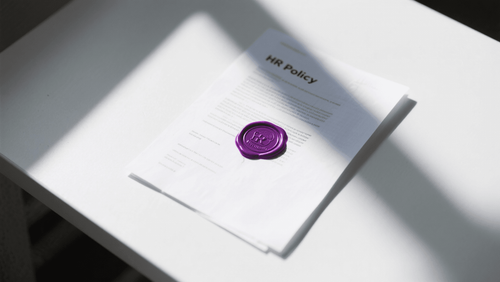Change Management in Human Resources: Strategies and Challenges

Is your organization undergoing a digital transformation that’s disrupting workflows? And how is your team reacting to new tools and structures? Change management in HR is the bridge that connects executive decisions to the reality employees live every day.
In Saudi Arabia, where teamwork, generational diversity, and Vision 2030 initiatives are accelerating, change can become an opportunity to improve performance and morale when managed with clarity and tangible support. By defining the “why,” empowering leaders, and supporting employees with practical training and continuous measurement, confusion fades and trust grows.
In this article, we’ll explore effective HR change management strategies, the main challenges of managing change, and how to reap the benefits of structured change management, such as increased productivity and employee satisfaction.
The Importance of Change Management in Human Resources
When change happens without clear direction, anxiety spreads, and rumors fill the gap. Effective change management gives everyone a clear picture and answers key questions: What exactly will change? What will stay the same? When will we be updated?
This transparency builds trust and reduces resistance, helping people adapt more smoothly.
Research from Prosci shows that initiatives with excellent change management are seven times more likely to achieve their goals than those with weak implementation—a compelling reason for decision-makers to invest early in communication, training, and measurement.
Improving Performance:
Employees perform better when they clearly understand what’s expected. This reduces errors and accelerates progress because the path is clear, support is available, and questions are welcomed.
Encouraging Innovation:
Change fosters experimentation. When employees feel safe, they share new ideas and test better ways of working—turning innovation from a slogan into a daily habit.
Effective Strategies for Managing Change
There’s no one-size-fits-all recipe in business, but these golden principles consistently prove effective in HR change management:
1. Communicate Effectively
Start with the story, not the policy. Explain why before what and how. Use simple language, short and repeated messages. Make the direct manager the primary messenger, and provide them with key talking points and ready-to-share scripts. Use mixed channels—brief meetings, short updates, and open Q&A spaces.
2. Focus on Training and Development
Offer short, focused training instead of long, exhausting sessions. Link every module to real workplace situations—a task, a system, or a new process. To reinforce learning, send a 1-minute reminder video or slide two weeks later, and ensure all resources are easily accessible on mobile.
3. Governance and Ownership of Change
Define who leads, who decides, and who reviews. Assign executive sponsors, operational leaders, or “change ambassadors” across teams to keep momentum and accountability high.
4. Measure Employee Sentiment
A short 3–5 question survey every two weeks is enough to identify pain points. Share results with teams and explain what actions will follow.
Change Readiness Matrix (Practical Model)
| Group | Expected Attitude | What They Need | Risk if Missing | HR’s Role |
|---|---|---|---|---|
| Executive Management | Supportive | Clear KPIs and risk map | Mixed messages | Unify messaging and follow-up |
| Direct Managers | Cautious or busy | Communication scripts & FAQs | Silent resistance | Coaching & empowerment |
| Frontline Employees | Anxious about the unknown | Practical training & quick support | Errors and delays | Short materials & help channels |
| Internal Partners | Affected by procedures | Unified forms & timelines | Process conflicts | Align operations |
A Simple 90-Day Plan (Adaptable to Any Organization)
Days 1–15: Planning and Preparation
Define the scope of change, create a clear vision, assign roles, and prepare communication and training materials.
Days 16–45: Implementation and Engagement
Leaders deliver unified key messages, short training sessions are launched, and interactive channels open for employee questions.
Days 46–75: Follow-Up and Adjustment
Gather feedback to measure adoption and adjust communication or training as needed. Provide extra support where challenges persist.
Days 76–90: Evaluation and Sustainability
Assess results against objectives, document lessons learned, and design a sustainability plan to embed change into company culture.
Common Challenges in HR Change Management
Even the best plans face obstacles. Here’s how to anticipate and minimize them:
Resistance to Change
Fear is natural. Address it with clear facts, highlight quick wins, and create safe spaces for questions. Tailor your message to each audience—one message rarely fits all.
Limited Resources
Time and budget constraints are common. Focus on critical “moments that matter”—like practical, just-in-time training instead of lengthy theoretical sessions.
Priority Overload and Fatigue
When too many projects run at once, people burn out. Link each change to team goals, drop unnecessary tasks, and schedule brief recovery periods between phases. This keeps energy and focus high.
The Benefits of Change Management in HR
When applied methodically, HR change management delivers visible results in a short time:
Higher Productivity
Tasks get done faster because guidance is clear, resources are available, and support is ongoing. Less time is wasted searching for answers.
Greater Employee Satisfaction
Clarity and belonging increase morale. When employees are heard and informed, they commit more, support colleagues, and create a more positive, stable workplace.
Faster Transformation and Lower Risk
Rolling out change in phases, with early testing and continuous measurement, reduces costly mistakes and improves the quality of outcomes.
Key Success Metrics (What to Track)
Choose three simple indicators such as:
-
Average task completion time after change
-
Training participation rate
-
Employee confidence score (1–5 scale)
Share results monthly and link improvements to concrete actions—like updating guides, adding a short explainer video, or hosting a Q&A session.
Empowering Line Managers: The Decisive Factor
Direct managers are the most powerful influencers in any change process. Provide them with a Change Toolkit that includes:
-
A concise summary of what’s changing
-
A single-slide visual explaining key expectations
-
Clear answers to common questions
-
A simple implementation timeline
These resources make a huge difference on launch day, giving managers the clarity and confidence to lead their teams effectively.
Common Mistakes to Avoid
Launching Change Without Clear Vision or Sponsors
Every change must have a compelling story and visible executive sponsors. Without them, confusion and rumors spread quickly.
Relying on Long Theoretical Training
Avoid draining sessions; focus on short, hands-on training that employees can apply immediately. Real learning happens when it connects to daily tasks.
Ignoring Employee Feedback
Always measure sentiment. Neglecting it allows silent problems to grow unnoticed, eventually leading to slow failure.
Conclusion: How Coursinity Can Support Your HR Change Management
Change is constant, the real question is whether you’ll manage it consciously or let it manage you.
Effective HR change management gives teams clarity and transforms anxiety into positive energy. Start small: one clear message, one short training, and consistent measurement. With every cycle, your organization becomes faster and calmer in adapting to new realities.
If you want a guided change journey led by experts who walk with your team step by step, Coursinity is your partner. We design interactive learning journeys, not just training sessions, supported by regional experts, engagement tracking, performance reports, and tailored calendars.
With Coursinity, you achieve high impact at lower cost, blending global expertise with local understanding, so your organization doesn’t just talk about change, but lives it and thrives through it.
Book a Demo Now
FAQs
What is Change Management in Human Resources?
It’s a structured approach to preparing individuals and teams for changes in systems, processes, or structures. It includes storytelling, ongoing communication, short training bursts, continuous measurement, and real-time support—all designed to reduce resistance and maximize adoption with minimal stress and downtime.
How Can HR Improve Change Management?
Start by defining “why we’re changing” in plain language. Appoint sponsors and change ambassadors. Build clear HR change management strategies: short messages, practical training, bi-weekly sentiment surveys, and a simple risk map. Tackle challenges early—and you’ll see the benefits in productivity and satisfaction within weeks.
Latest Posts


